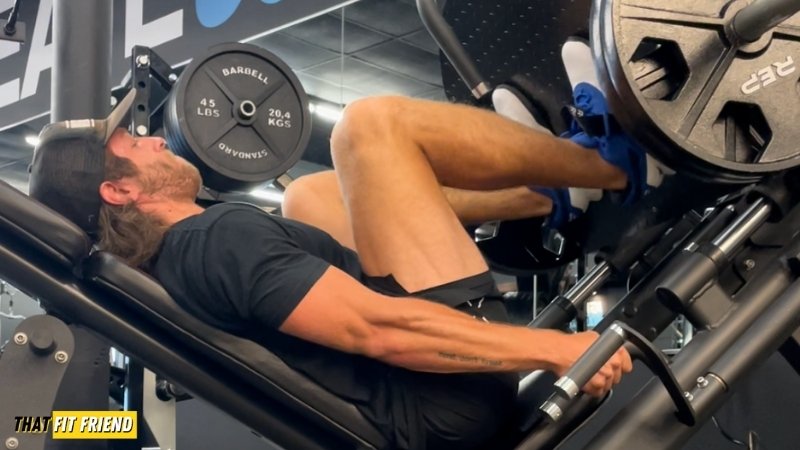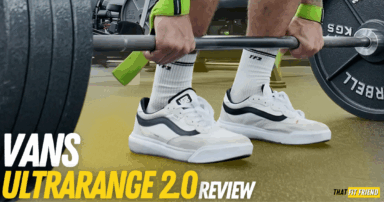When most lifters think about weightlifting shoes, also referred to ask squat shoes, their minds typically go straight to wearing them for squats, snatches, and clean & jerks. Yes, these are the most common exercises to wear weightlifting shoes, but they’re certainly not the only time you can wear weightlifting shoes for your training.
For example, you can wear weightlifting shoes for machine-focused strength such as leg presses, pendulum squats, and hack squats. Now, if you’re thinking, “Wait, you can use weightlifting shoes for machine work?” Yes, you absolutely can. Read on to learn more about how to utilize them efficiently.
Like most pieces of supportive strength gear, weightlifting shoes are dynamic. If we can better understand how to utilize weightlifting shoes in our training, then we can be much more strategic with how we implement them into different exercises.
In this article, I want to discuss the topic of using weightlifting shoes on machines and when lifters should employ them. You won’t always wear weightlifting shoes for your lower body machine work. However, there are contexts where they make sense.
Can I Wear Weightlifting Shoes When Using Machines?
While it may not be common to do so, you can certainly use weightlifting shoes when training on machines like the leg press, pendulum squat, and hack squat.
When conceptualizing this question and topic there are two key thoughts to keep in mind when making your footwear selection and these include.
- How the machine is built and your anatomy.
- What training adaptations you’re after.
If you can remember these two concepts, then relate them to one another for your training you can make better gear selection. On a side note, you can actually apply the above to all of your training when considering using supportive strength gear.
Consideration 1: How the Machine Is Built and Your Anatomy
When we look at machines in our gym, it’s pretty clear to see that they’re all built slightly differently. Let’s look at a leg press or hack squat for this example.
There are multiple types of leg presses and hack squats and different companies will construct their equipment slightly differently. This means that different leg presses and hack squats will have different seat setups, different platforms, and different paths of resistance upon which the leg press moves.
In addition to the differences we can see with each leg press and hack squat machine, we’ll also want to account for our individual anatomies. Different bodies will be better optimized for certain types of leg presses.
A great real-life example of this is me and my girlfriend. I’m 6′ 0″ and she’s 5′ 1″, we both use the same leg press at the gym, but how we position ourselves on this piece of equipment is different along with how we can leverage the machine to driver certain adaptations.
In the image above, my friend Kevin is 6′ 3″ so he uses weightlifting shoes for assistance with achieving greater ranges of motion on the hack squat at his gym. If he wasn’t trying to hit bias his adductors and quads and hit full depth, then he could use regular training shoes without an issue.
Now, how does all of this relate to weightlifting shoes in a practical manner?
Well, when we consider all of the differences discussed above, weightlifting shoes can be a great tool to allow us to better achieve the ranges of motion we’re after if the leg press in question doesn’t align well with our anatomy.
Let’s say you’re a taller lifter and the leg press’s seat is positioned at a sharp angle and the platform is pretty close to the seat. In this example, you may have a really difficult time achieving full range of motion through the eccentric (lowering portion) of the movement without the lower back rounding and coming off the seat.
The back coming off the seat could be a result of the poor leg press construction and your anatomy or something like your limited dorsiflexion and hip mobility. Either way, a weightlifting shoe can provide you with an additional .75″-1″ of heel height to help assist with your range of motion and prevent the back from coming off the seat.
By adding this heel wedge, we’ll be in a better position to assist our dorsiflexion specifically which can then help with achieving greater ranges of motion when a machine doesn’t align well with our body.
In this example as well, the heel wedge will also help limit how deep our hips go into flexion at the bottom of the leg press, so if you are limited there, then a weightlifting shoe could help you to stay grounded in the seat.
Consideration 2: What Training Adaptations You’re After
Once you’ve looked at the machines you’re working with and have considered your anatomy and limitations in regard to mobility, now it’s time to consider how weightlifting shoes could assist with the adaptations you’re after.
A great example here is how weightlifting shoes can help to promote a quad bias when using machines. In fact, this is one of the most common reasons for using weightlifting shoes with machines like leg presses, hack squats, and pendulum squats.
As a general rule of thumb, when we increase the amount that the knees are tracking over the toes, then we’ll increase the demands we’re placing on the quads.
If the knees can track more, then we’ll place a greater stretch on the quads through the eccentric (lowering portion of the movement), and with this greater stretch, the demands for knee extension will also increase (AKA how much we’re getting out of the lifting/standing up/pressing portion of the movement).
By utilizing weightlifting shoes, we can ensure we’re hitting greater ranges of motion on certain machines and promoting more knee tracking to target and bias the quads to our best abilities.
If you want to try this, then I’d suggest placing your feet slightly lower on the platform of the machine that you’re using and focusing on promoting the knees to track to create a greater stretch and promote more tension on the quads.
Conversely, you can also create a glute bias with weightlifting shoes by placing the feet slightly higher on the platform and grounding the hips and back while limiting how much the knees are tracking during the eccentric and concentric (lowering and lifting) movement patterns.
Key Takeaway Points
Like with everything in the gym and with our training, there are multiple layers present when considering exercise gear usage, exercise selection, and exercise execution. Below, are two key take-home points from this article that you can and should utilize for your training.
- Weightlifting shoes can be useful tools on weight machines when a machine’s construction doesn’t align perfectly with your anatomy. At times, weightlifting shoes can allow us to achieve greater ranges of motion with better and stronger body positions.
- Using weightlifting shoes on machines can be useful tools for driving specific muscular hypertrophy and strength adaptations such as quad, adductor, and glute biases.
More than likely, most of your training on leg presses, hack squats, and pendulum squats will be without weightlifting shoes, however, that doesn’t mean they don’t and can’t have use for your training.
Consider the above two points when employing and asking the question of, “Will weightlifting shoes support and improve my performance per the tasks and demands I’m trying to achieve?”
If you have any questions on this topic, drop a comment below or reach out to me personally via Instagram (@jake_boly).











Add a Comment